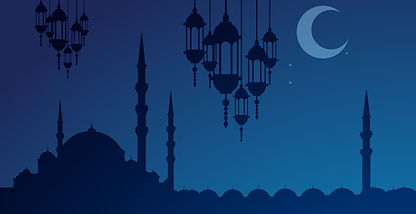Islam


The Koran and prayer beads
Islam is another monotheistic religion and the second most popular religion in the world with over a billion followers. Islam is the third of the Abrahamic religions after Judaism and Christianity. A follower of Islam is called a Muslim. This religion began about 600 years after Christianity.
A man named Muhammad, born in 570 CE, believed he was visited by the Archangel Gabriel (believed in Christianity to have told Mary that Jesus was the son of God). Gabriel told Muhammad the final message of God, which was later written down in a book called the Koran (also spelled Qur’an). The Koran is the Islamic holy book. Muslims call God “Allah”--the Arabic word for god.
The prophet Muhammad is the founder of Islam, and Muslims believe he was the last prophet of Allah—it is believed the first prophet was Adam (Adam and Eve). A prophet is someone who is believed to have spoken to a God and then repeats God’s message. Muslims believe there were many prophets before Muhammad including: Adam, Noah, Abraham, Job, Moses, John the Baptist, and Jesus. During Muhammad's life there were many smaller religions in the Arabian Peninsula--many of them were polytheistic (believing in many Gods). They would often have small statues and symbols of their gods, called idols. An idol is an image or representation of a god. A big part of Islamic belief is absolutely no idol worship--no representations of God or Muhammad. That is why you rarely see Muhammad statues or paintings and if you do, his face is usually all white--so it doesn't become and idol people could worship.
Islam began in modern-day Saudi Arabia in a town called Mecca where Muhammad was born. Muslims do not think of Muhammad as the founder of a new religion, but as the restorer of the original monotheistic faith of Abraham, Moses, Jesus, and other prophets. Muslims believe that Jews and Christians have distorted the original message of God. The Arabic word 'Islam' means submission, as in submission to God.

16th-century Siyer-i Nebi image of angel Gabriel visiting Muhammad

Sheikh Zayed Grand Mosque in Abu Dhabi, United Arab Emirates
The Muslim place of worship is called a mosque (mosk). Very often mosques have a domed roof and at least one tall tower called a minaret. Muslims often hear the "call to prayer" from a minaret, reminding Muslims to pray 5 times each day. There is also very little furniture inside a mosque because Muslims use “prayer mats” to kneel on when they pray. When people go into the mosque they take off their shoes. This is to keep it clean for prayer. Women do not usually pray in the same place as men. Men are expected to attend the noon prayer at the central mosque in town. To accommodate large attendance, mosques often have a large, open courtyard where Muslims lay down their prayer mat.
You won't find statues or large murals showing people or events from the Koran, like you would in a Christian church. This is due to the Islam a strong culture and history against idol worship. It isn't just images of Muhammad and people--it's all living things such as cows and other animals. This comes from the belief that it is God who "creates life". So, most of Islamic art includes geometric shapes, calligraphy (artistic handwriting), and arabesque. Arabesque consists of decretive, intertwined flowing lines that look like vines. You will find this style of art on plates and glassware, as well as inside mosques.

Geometric and floral designs inside mosque

The Kaaba at Masjid al-Haram in Mecca, Saudi Arabia, the holiest Islamic site
There are 2 major denominations in Islam—Sunni (soon-ee) and Shi’a (she-ah). Almost 90% of Muslims are Sunnis. The Shi’a split from the Sunnis in 632 CE when Muhammad died. They disagree about who should lead Islam and how they should be chosen. However, all Muslims agree on several things. The month of Ramadan is the most important holiday for all Muslims; it is a time of sacrifice in an attempt to focus on Allah. Part of that sacrifice is fasting (not eating) during daylight hours--for 29-30 days! Ramadan is observed from one crescent moon till the next. This is one reason the crescent moon often symbolizes Islam, not officially of course--that would be too close to an idol. Another very important part of Islam is the 5 Pillars of Islam—similar to the 10 Commandments of Judaism and Christianity.
Jerusalem is the 3rd holiest city of Islam. Mecca is the most holy city and also contains the most holy mosque. In the center of the mosque is a cube-shaped building called the Kaaba (Ka'bah). All Muslims face the direction of the Kaaba during prayer--no matter where they are in the world. All mosques have a place that shows the direction of the Kaaba. Muslims are supposed to pray 5 times every day. The times of prayer are closely related to the phases of the sun such as sun-up and sun-down. Muslims do not have priests; they don’t believe they need a “middleman” between themselves and Allah (God). An Imam (i-mom) leads local prayer and takes care of the mosque. Similar to Christians, Muslims believe in Heaven and Hell.



Ramadan is a month-long Islamic holiday, from one crescent moon to the next

Muslim practicing Salah - Praying 5 times each day
The 5 Pillars of Islam are required of all believers of Islam:
-
Shahadah--is a statement of belief in monotheism and accepting Muhammad as God's messenger.
-
Salah--the requirement to pray 5 times a day at dawn, noon, mid-afternoon, sunset, and night.
-
Zakat--is the practice of giving to charity; about 3 percent of your individual wealth.
-
Sawm--Muslims must abstain from food and drink from dawn to dusk during the month of Ramadan
-
Hajj--expectation to make a pilgrimage to Mecca at least once in their lifetime if they can afford it.
